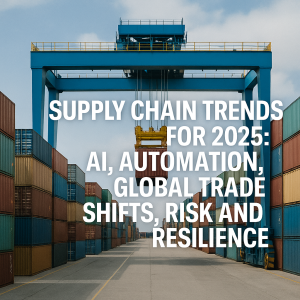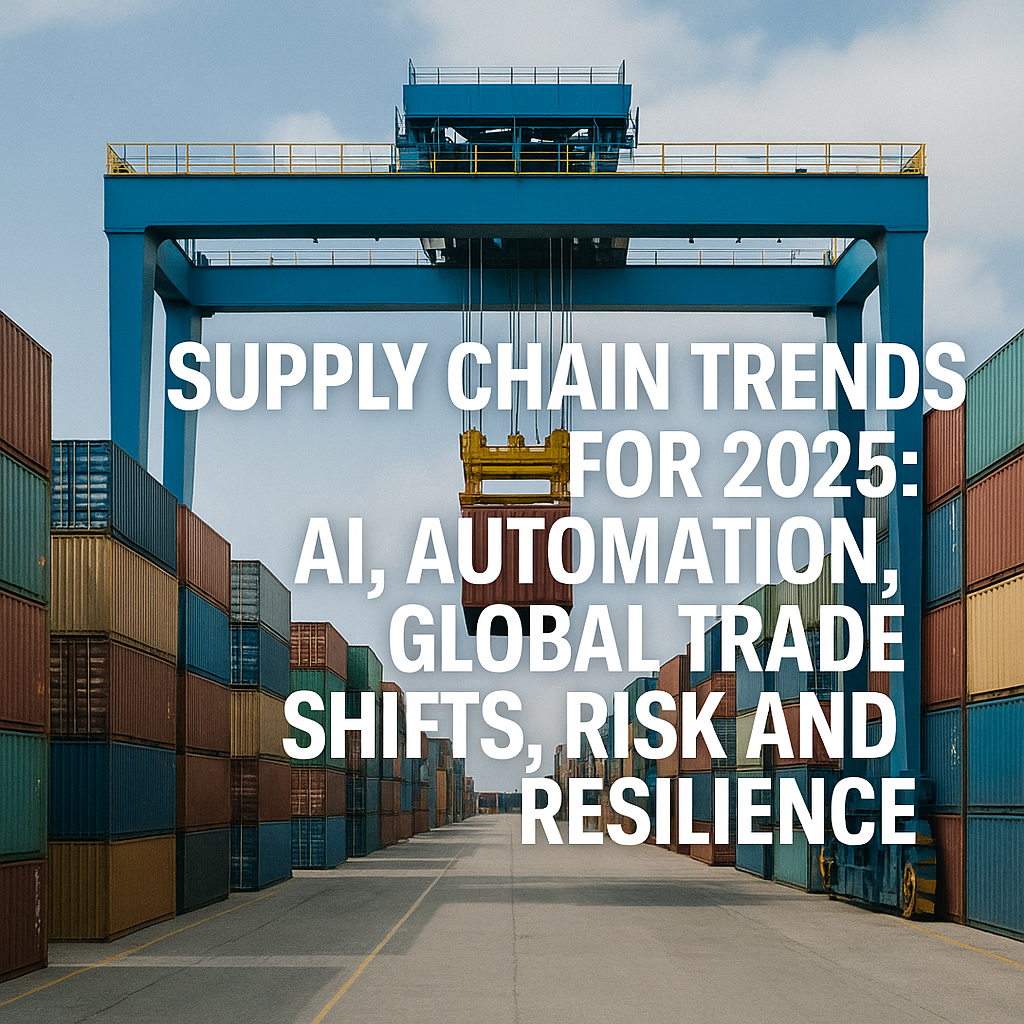
Discover the top supply chain trends for 2025 shaping the maritime and logistics industry. Learn how AI, automation, shifting global trade patterns, and resilience strategies are redefining global shipping networks.
Why Supply Chain Trends in 2025 Matter More Than Ever
If there is one thing that the last few years have shown us, it is that supply chains are no longer quiet, invisible systems working behind the scenes. From the Ever Given blocking the Suez Canal in 2021 to COVID-19 lockdowns that froze entire port networks, supply chains have become front-page news and boardroom priorities.
Now, as we step into 2025, the maritime and logistics industry faces a fresh wave of transformation. Artificial intelligence (AI) and automation are no longer buzzwords; they are embedded in daily operations. Global trade is shifting as geopolitical realignments, decarbonisation policies, and regionalisation reshape routes. Risk management has evolved into a resilience-driven strategy, as shipping companies, ports, and regulators prepare for climate shocks, cyberattacks, and market volatility.
This article dives deep into the major supply chain trends for 2025, with a maritime lens—exploring how technology, trade patterns, and resilience planning are reshaping the very backbone of global commerce.
Artificial Intelligence in Supply Chains: Beyond Predictions to Autonomous Operations
AI has been creeping into maritime logistics for over a decade, but 2025 marks a turning point. Instead of using AI solely for forecasting, companies are deploying it in decision-making, vessel routing, predictive maintenance, and even emissions reduction.
Smarter Vessel Routing and Port Calls
Platforms like MarineTraffic, Inmarsat Fleet Data, and predictive tools developed by DNV and Wärtsilä Voyage now use AI to anticipate congestion, weather events, and fuel efficiency. For instance, an AI-driven “just-in-time arrival” system allows ships to adjust speed to avoid waiting at anchorage, saving both bunker fuel and reducing port congestion. According to the International Maritime Organization (IMO), optimizing vessel arrival times could reduce CO₂ emissions by 6–10% per voyage.
Predictive Maintenance in the Engine Room
Ship operators are moving from scheduled maintenance to condition-based systems. Sensors feeding AI models can predict failures in pumps, compressors, or even propulsion systems before they happen. This not only reduces downtime but also saves millions in repair costs. Lloyd’s Register recently reported that predictive maintenance could cut unplanned downtime by 30%.
AI-Powered Trade Forecasting
Institutions like UNCTAD and IHS Markit (S&P Global) are harnessing machine learning to predict global cargo demand. With geopolitical uncertainty around the Red Sea and the Panama Canal’s drought-induced delays, AI forecasting tools are becoming vital to reroute vessels and rebalance capacity.
Automation: From Ports to Floating Warehouses
While AI makes decisions, automation physically executes them. In 2025, supply chains are witnessing “smarter hands” at work—from autonomous cranes to drone inspections.
Automated Ports Leading the Way
China’s Yangshan Deep-Water Port and Rotterdam’s Maasvlakte II are already fully automated with remote-controlled cranes, AGVs (automated guided vehicles), and digital twins. In 2025, similar technologies are expanding to Southeast Asia and the Middle East, where ports like Jebel Ali (UAE) and Singapore’s Tuas Mega Port are integrating robotics.
Automation not only increases efficiency but also boosts resilience. During COVID-19, automated terminals could continue operations with limited human intervention, providing a model for pandemic-proof logistics.
Warehouse Robotics and Maritime Link
Automation is not limited to ports. The entire maritime logistics chain is now connected to automated distribution centers, where robots pick and pack containers for hinterland transport. This makes seaports function as part of an extended “floating warehouse system.”
Autonomous Vessels and Drones
The industry is also testing remote and semi-autonomous ships. The Yara Birkeland, the world’s first electric autonomous container vessel, is no longer just an experiment but a working model in coastal trade. Drone inspections, meanwhile, are becoming common for hull surveys and inventory checks, reducing risks for seafarers.
Global Trade Shifts: From Globalisation to “Nearshoring”
The geography of trade is shifting. Supply chains are diversifying to reduce dependency on single choke points or regions.
The Decline of Single-Hub Dependence
For decades, China was the “factory of the world.” In 2025, production is dispersing. Countries like Vietnam, India, and Mexico are becoming manufacturing alternatives, as firms look to diversify away from overreliance on one country. This trend, known as “China+1”, is rewriting shipping demand across the Pacific and Indian Oceans.
Climate and Water Constraints
The Panama Canal, facing prolonged droughts, has reduced vessel draft allowances, slashing daily transits from 36 to 24 ships in 2023–2024. This has shifted trade back toward the Cape of Good Hope and the Suez Canal. With climate unpredictability, shipping companies must plan for multiple routing scenarios.
Geopolitical Realignments
Conflicts in the Black Sea and Red Sea have already disrupted container and tanker flows. According to Clarksons Research, container vessels rerouting around Africa increased voyage distances by 20–30% in 2024, directly affecting fuel costs and schedules.
Regionalisation and Short-Sea Shipping
Meanwhile, Europe is investing heavily in short-sea shipping through TEN-T corridors, encouraging more intra-European transport via sea to reduce road congestion and emissions. This trend is mirrored in Asia, with ASEAN strengthening intra-regional maritime corridors.
Risk and Resilience: The Core of Future Supply Chains
If AI and automation are the new tools, resilience is the mindset driving supply chain strategies in 2025.
Climate Resilience
Ports and terminals are strengthening seawalls, elevating critical infrastructure, and investing in renewable-powered facilities. The European Sea Ports Organisation (ESPO) highlights that over 60% of EU ports now have climate adaptation strategies in place.
Cybersecurity
Digitalisation brings efficiency but also risks. The IMO’s MSC-FAL.1/Circ.3 guidelines on maritime cyber risk management are now mandatory under the ISM Code. After high-profile cyberattacks on Maersk (2017) and Damen Shipyards (2021), shipping companies are investing in AI-driven anomaly detection and blockchain-secured documentation.
Multi-Layered Redundancy
Resilient supply chains are no longer about avoiding disruption, but about adapting to it. Shipping companies are diversifying fuel suppliers, building alternative logistics corridors, and investing in dual-powered vessels (LNG + methanol).
Case Studies: Supply Chain Adaptations in Action
Maersk and End-to-End Logistics
Maersk has reinvented itself from a pure shipping line into an integrated logistics provider. By acquiring warehouses, air freight capacity, and digital platforms, it offers customers a single-window solution—making supply chains more resilient and visible.
Singapore’s Digital Twin Port
Singapore’s Tuas Mega Port, operational since 2022, uses a digital twin model that integrates real-time cargo, weather, and traffic data. In 2025, it is a case study in how AI and automation can make a port both greener and more efficient, aiming for net-zero operations by 2050.
Resilience in the Baltic Sea
With the risk of ice seasons extending due to climate volatility, ports like Helsinki and Gdansk are investing in ice-class vessels and digital ice-routing systems. This reflects the new resilience playbook: anticipate, adapt, and absorb shocks.
Future Outlook: What Lies Beyond 2025
The next wave of supply chain innovation will come from convergence. AI, automation, and decarbonisation will not operate in silos; they will merge into integrated platforms. Imagine a vessel in 2030: powered by green ammonia, routed by AI, maintained by predictive digital twins, and connected seamlessly to an automated port and hinterland rail network.
The IMO’s revised GHG strategy (2023) sets a net-zero ambition by 2050. This will transform supply chains into low-carbon ecosystems, where carbon intensity becomes as important a metric as cost or speed.
Meanwhile, trade patterns may further fragment into regional blocs, with more emphasis on resilience than efficiency. The global supply chain of 2025 is not just about moving goods—it is about building trust, adaptability, and sustainability.
Frequently Asked Questions (FAQ)
1. How is AI changing supply chains in 2025?
AI is shifting from forecasting to operational control. It now manages vessel routing, predictive maintenance, and emissions optimization, making supply chains more efficient and resilient.
2. Why are global trade routes shifting?
Geopolitical tensions, climate disruptions (like Panama Canal droughts), and regionalisation are pushing companies to diversify routes and suppliers.
3. What role does automation play in ports?
Automation improves efficiency with robotic cranes, AGVs, and drones, while also reducing reliance on human labor during crises like pandemics.
4. How is resilience different from risk management?
Risk management focuses on prevention, while resilience emphasizes adaptation—ensuring supply chains can recover quickly from disruptions.
5. Are autonomous ships becoming mainstream?
Not fully, but semi-autonomous and remotely operated vessels like the Yara Birkeland show that autonomy is advancing, especially in coastal and short-sea trades.
6. What sustainability measures are ports taking in 2025?
Ports are investing in renewable power, electrified cranes, and infrastructure to withstand climate impacts, aligning with IMO and EU decarbonisation targets.
7. Will shipping costs rise due to these changes?
Yes, in the short term. Investments in technology and resilience add costs, but they create long-term savings through efficiency, fuel reduction, and avoided disruptions.
Conclusion: Navigating Supply Chain Futures in 2025
The supply chain trends of 2025 are not abstract predictions—they are unfolding realities. AI is already rewriting shipping schedules, automation is reshaping port terminals, and global trade is being redirected by climate and politics. For maritime professionals, students, and industry enthusiasts, the lesson is clear: supply chains are no longer passive. They are dynamic ecosystems requiring adaptability, foresight, and innovation.
As we sail into 2025, the challenge is not simply to react to disruption, but to design supply chains that thrive in uncertainty—chains that are intelligent, automated, resilient, and above all, sustainable.

